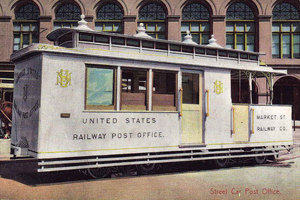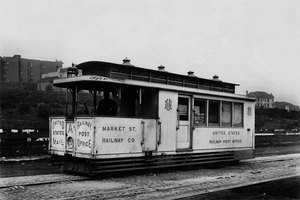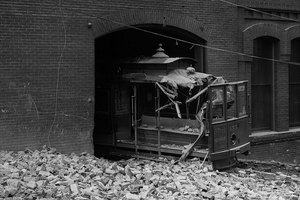Editor’s note: Our organization’s namesake, the Market Street Railway Co. (of 1893), consisted of the Market Street Cable Railway and many smaller competitors that its Southern Pacific owners had voraciously gobbled up. This and other business tactics won it the unflattering description of ‘Octopus’ in a San Francisco Chronicle article of February 19, 1895.
Six years later, Frank Norris took the term ‘Octopus’ as the title of his classic muckraking book about the Southern Pacific Railroad. An easy transference in Norris’ mind, no doubt, since the Market Street Railway Co. was controlled by the Southern Pacific.
In the early 1890s, the U.S. Post Office Department began nationwide studies to facilitate city mail delivery and processing using local rail transit systems. At the time, private wagons moved mail between San Francisco post offices. In June, 1894, former San Francisco mayor and state senator Frank McCoppin was appointed Postmaster of San Francisco and came up with a plan to transport mail between post offices in sealed pouches carried on street railway vehicles.
McCoppin felt that Railway Post Office (RPO) service — whereby mail was sorted, distributed, and picked up by onboard clerks — was inappropriate for San Francisco; the distance between post offices seemed too short to make it practical. However, the U.S. Post Office Department desired mail cars that provided a combination of closed pouch and RPO services, giving San Francisco a predominantly RPO operation.
The proposed service was primarily designed to provide rapid mail movement between the Ferry building and outlying post offices. The then-main post office at Battery & Washington Streets (site of today’s U.S. Custom House) was hopelessly inadequate and outdated. To solve this problem, Station D — the postal facility located at the Ferry Building — was emphasized. Almost all of San Francisco’s incoming and outgoing mail passed through the Ferry Building because of its links to the national rail network that terminated in Oakland.
Railway Post Office cars
The Market Street Railway Co. was the only San Francisco street railway to receive mail contracts. ‘The Market’ provided two types of mail service — RPO and closed pouch. The initial 1896 contract was only for RPO service. For this service, the company built three RPO cars. These had government-mandated bodies specially-designed for the onboard postal clerks to engage in pickup, cancellation, sorting, and distribution of the mail. All were painted in the government-required brilliant white with gold lettering and trim.
Both of the two cable car RPOs — cars A and B — were rebuilt from former Omnibus cable cars retired from either the abandoned Oak or Ellis cable car lines. The seats were removed and the car fronts enclosed to carry mail sacks. The enclosed passenger compartments were converted to complete RPOs, including washbasins, clothes lockers, and mail slots.
Car A received standard gauge trucks and a Root side-grip for operation on the standard gauge Market Street cable system. Following the termination in 1905 of the RPO contract, the history of car A is unknown.
Car B was shortened by four feet to 27 feet to allow it fit on the turntables and carhouse trackage of the former Ferries and Cliff House system. Since those lines were of the same gauge and grip style as the Omnibus lines, car B retained its original running equipment. Based at Washington and Mason carhouse, car B operated from the Ferry (west side of The Embarcadero) on the Sacramento-Clay line to Sixth Avenue and D Street [Fulton]. After the end of the RPO contract, car B was stored at the Washington & Mason carhouse, where it was destroyed during the 1906 earthquake and fire.
Electric streetcar C was constructed new by the Market Street Railway Co.; it was heavily built to pass RPO standards. Originally a single-truck car, in 1904 United Railroads upgraded it with a pair of Brill 27G trucks to improve its riding quality.
RPO car C served Post Offices adjacent to electric lines in the southern sections of San Francisco. It provided a direct connection from Station D at the Ferry to the new Main Post Office at Mission and Seventh Streets (now the U.S. Court of Appeals), where a spur track was built from the westbound Mission Street track onto the postal property.
San Francisco’s RPO service started on September 14, 1896. The service was primarily designed to provide rapid mail movement between Station D and outlying postal stations. The mail service in the affected areas was markedly improved. Various postal contracts and their routing from the Ferry’s Station D are set forth below:
Contract No. 376003 began RPO operations in 1896, using cable car A. This RPO route ran from the Ferry Building to Hayes and Stanyan via the Market and Hayes cable line (later the 21-line). It served postal stations K (the Palace Hotel), B (originally at 14 City Hall Avenue, later 1610 Market Street), and H (Hayes and Laguna). Added to this contract in 1900 were two closed pouch schedules using regular Hayes Street cable cars, along with closed pouch services under another contract, using regular Market and Castro cable cars to serve stations B and G (at 17th and Market Streets). In 1904 — after the Market Street Railway Co. gave way to United Railroads — a new closed pouch service was added to serve new station J at Haight and Masonic using Market and Haight revenue cable cars.
Contract 376004 established RPO service on the Sacramento-Clay line from the Ferry Building to Sixth Avenue and D Street (now Fulton). Narrow-gauge cable car B was used. Served were stations A (Sacramento and Polk Streets), F (Sacramento and Fillmore), and M (Sixth Avenue and Clement). After the 1902 cutback of the Sacramento-Clay cable to Walnut Street, station M received closed pouch service under a new contract by regular passenger cars of the replacement Turk and Eddy electric line.
376005 was an RPO service, which initially used several electric streetcar routes to serve North Beach and the Mission, using electric streetcar C. Starting in 1896, the route ran from the north ferry terminal via East Street (now The Embarcadero), Broadway, Stockton to Green, serving station J at 424 Montgomery (now Columbus Avenue). The RPO preceded west on Green Street and north on Powell to Filbert where, by means of crossover, it reversed direction. After reversing direction, Car C ran to station C at Mission and 20th Streets via Powell, Broadway, Kearny, Third, and Mission Streets. At 22nd Street the RPO car reversed direction again, running directly to the south ferry terminal via Mission Street. This route was later reversed. Then, when station J closed in 1897, all service under this contract ran from the south ferry terminal via Mission Street to 22nd Street and return.
On January 1, 1900, closed pouch service using regular Mission Street streetcars was concurrently established between the Ferry Building and Station C at Mission and 20th Streets. Station K at the Palace Hotel was also served by both Car C and the Mission closed pouch service.
When regular service revenue cable cars were used in closed pouch service, the two identical forward-facing seats in the front of the car were used to store the closed mail pouches (this type of seat no longer exists on cable cars). These seats were separated by a narrow open section to accommodate the operation and removal of the large Root side-grip. Curved screens were mounted on the inside of these two seats to protect the passengers from the grip. A maximum of four closed pouches were carried in the front of a car when these seats were chained off; the remainder were likely placed in the closed section. Additional pouches could be placed on the benches in the open section and several strands of manila rope would be tied to the stanchions with drayman’s or trucker’s knots as a security measure. Regular service cars — both cable and electric — carried a sign in their front window that read U.S. MAIL when they were in closed pouch service.
With minor exceptions, the postal contracts were unchanged at the time United Railroads took over the old Market Street Railway Co. in 1902. For a short time afterward — October 10, 1905 to April 18, 1906 — closed pouch service was operated from the Ferry Building via Mission Street to the Seventh Street Main Post Office using two identical rebuilt United Railroads cars that were assigned the letters D and E. These 29’6″ cars had been built by J. Hammond & Co. in March, 1900 for the San Francisco and San Mateo Electric Railway. Stranded on Mission Street when the power failed as a result of the April 18, 1906 earthquake, they were consumed in place by the subsequent fire. (One car from this same Hammond order, rebuilt over and over, survives today as Muni line car No. 0304.)
Postal administrative changes, but RPOs continue
After the May, 1897 death of Frank McCoppin, W.W. Montague — for many years associated with Southern Pacific — became San Francisco’s postmaster. In August, 1899, the U.S. Assistant Postmaster General requested a report from Postmaster Montague regarding the viability of San Francisco’s RPO routes. Montague wrote, “The distances are too short. Probably 80% of the mails collected are taken when the cars are not but ten minutes from the terminus at Station D. No satisfactory or profitable work can be performed in so short a time.”
Nevertheless, RPO service continued for a time until September, 1905 when postal authorities conceded that McCoppin and Montague were correct — the routes were too short. Closed pouch services ended with the 1906 earthquake. United Railroads facilities were devastated — they actually restored much of their trunk transit service before other utilities were back in service, yet the U.S. Post Office Department held it in default of its contract and cancelled the contract outright for failure to provide the required service. Mail movements between Post Offices in San Francisco reverted to horse and wagon, switched not long afterward to then-marginally performing motor trucks.
It is not clear from available documentation why the U.S. Post Office Dept. took such a hard line against United Railroads following this natural disaster. Labor unrest and corruption may have played a role. United Railroads, like the Market Street Railway Co. before it, wanted mail contracts largely to have the leverage of the U.S. government in the advent of disruptive labor action. On August 26, 1906, United Railroads car operators went on strike demanding three dollars pay for an eight-hour day (they were working ten). Work resumed September 6, 1906 with the dispute going to arbitration. The following year, however, the car men struck again, seeking the same terms; United Railroads brought in strikebreakers. The strike lasted four months, one of the most difficult and violent in San Francisco history. Meantime, charges of corruption, including bribery of the Mayor and Board of Supervisors, swirled around United Railroads.
But that’s another story. This one — moving the mail by cable car and streetcar in San Francisco — came to an end when the earth shook and the sky burned a century ago.



